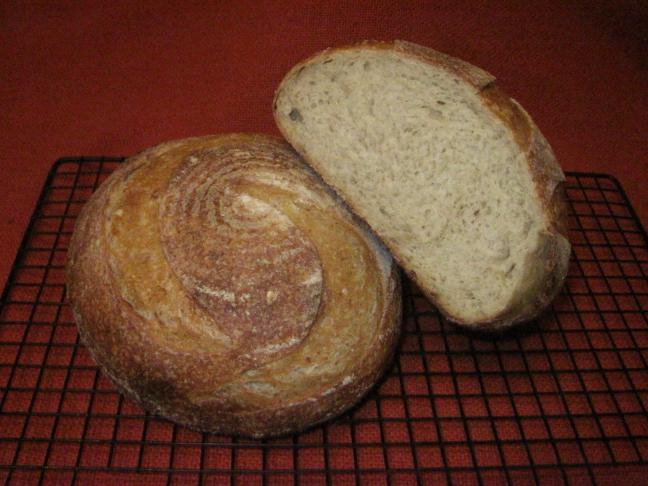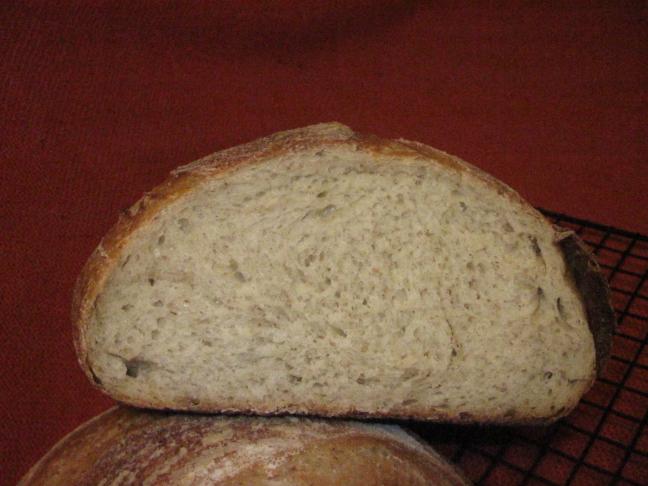

I’ve been nursing a starter from a San Francisco sourdough culture I bought from Dr Ed Wood several years ago. Though the starter was still raising bread nicely, I found that over time the sourdough taste had gradually diminished to the point that I had begun using citric acid to boost the sour flavor in my breads.
At the suggestion of Eric Hanner I began feeding my starter twice a day, allowing it to stay out at room temperature rather than refrigerating it after the doubling, which had been my habit. I also converted my liquid starter to a 50% hydration firm starter. I continued the on-the-counter feedings over the course of about 5 days until I decided to try it out on a Vermont Sourdough recipe this weekend.
These boules were baked side by side using a cold-start oven and covered with a stainless steel bowl for the first 30 minutes of the bake at 500 degrees. After that the temperature was lowered to 470 for the final 20 minutes, and then the boules remained in the oven for another 5 minutes with the door cracked open and the heat turned off.
The color was a nice dark hue and the crust was thin and crackly. I was a little disappointed in the crumb, as I missed those big, open holes I usually get from this recipe. It’s possible I didn’t proof the loaves long enough. But the texture was moist and chewy and very tender so I'm not complaining.
All told though, the story was in the taste. I have to assume it was all the extra TLC given to the starter, but I feel I'm finally on my way to achieving the flavor I've been after. I know it’s going to take longer than a just few days to get my starter truly back up to snuff, but I would consider this a very good start.
If you want more sour from your sourdough, I suggest you try this simple technique. It’s easy, inexpensive, and effective.
Barbara
First I must say those are some seriously nice looking boules!
So when you cold start the oven, you just load the bread. Do you bake them on pans or on a stone/tiles? I am curious about this since I now have a new propane stove, I am almost starting over in baking it seems. So I am looking at all kinds of new ideas.
Also, do you think converting to a firm starter helped your flavor and rise, or just the flavor? I ahve problems with sourdough breads that are not spiked with yeast. I always get this weird taffy like dough. I don't know if it is because my starter os overripe from being too liquid. So I was curious what you noticed in the difference between the 2.
Thanks.
Hi Jani,
Thanks for your nice comments, I do appreciate them!
To answer your questions, yes, I just loaded the bread onto a cookie sheet right into a cold oven, covered the loaves with two stainless steel bowls, side by side, closed the oven door and cranked up the heat. (I have a gas oven.) Though I usually use a baking stone, this would only be useful if it was preheated, and it takes me about an hour to get the stone up to temperature. That's the reason I used a cookie sheet instead, and I didn't feel the bottom crust suffered all that much from it. The bowl covers provided just enough steam to give a nice crust.
I have been using a liquid starter for most of my sourdough baking "career" and have never really had trouble with dough rising. It's the flavor that's always been lacking, and since I switched to a firm starter, I do taste more of a sourdough taste. The firm starter I developed from my liquid starter has been showing good signs of life, doubling after a couple of hours and tripling overnight, so I think its rising capabilities are adequate.
I hesitate to give you any advice with regard to your starter because there are a lot of people here who know so much more about it than I do, but maybe if you tried the refreshment technique I used here, you would see a difference.
What I did was to start with 25 grams of my liquid starter and then begin adding 50 g water and 100 g flour twice a day for a few days, and then once a day when it appeared to be active enough. During this process I kept the starter on the counter and discarded any excess to keep my culture at about 175-200 grams. I figure that once I get the starter up to full speed, I can begin to refrigerate it between feedings, and decrease or increase the volume as I need.
I hope this works for you, Jani, as it did for me. Good luck!
Barbara
Janij,
If your feeding schedule is giving over ripe starter, you will definitely appreciate the benefits of a firmer feeding ratio. The ratio I like is 1 part old starter, 3 parts water and 4 parts white flour. That works out to a semi firm 75% hydration mix. It is easy to mix up and seems to be just the right amount of food to be strong at 12-14 hours at room temperature. Depending on where you live, we are in a season change now. For me in the US Midwest, it is getting warmer and everything is working faster in my culture. A few degrees matters. The yeast AND the bacteria will become more active and healthy with a better food supply and warmer climate.
Eric
When I get back to the farm I will try moving my starter to a firmer starter. I have found baking bread at our new house, the farm, is very different. It doesn't have central air at the moment or central heat for that matter. But right now in East Texas that isn't a problem except rising times are a lot longer if the room temp is 62 not 72. Plus I have a propane stove and that is just a bit different. But I want to really work on making better straight sourdough breads. So when I get back I will convert the starter to firm and see how it goes. I think mine was getting too ripe and I would miss the really active window and then I have an acidic mess! So thanks for the tips and I will let you know how it goes.
Your bread looks great and I'm happy to hear the taste is improving. Be patient with the process. It will improve with time. I might suggest that you add a small amount of additional water in your dough mix, may 1 or 2 % to help improve the aeration in the crumb and as you say perhaps a little more proof time.
You can see how feeding to a higher ratio of flour gives the creatures a better food supply that lasts longer than one with more water. You might also give your firm starter a stir or a brief knead in the middle of the day, just to provide some fresh food for the static bacteria. 24 hours is a long time between feedings once it is healthy. I wouldn't be in a hurry to refrigerate it unless you need to for a few days. Let us know how things are going.
Eric
Thanks Eric, I'll keep all of those things in mind. It's a constant tweaking process, isn't it? But I feel I'm getting the hang of it. Thanks for your on-going help.
Barbara